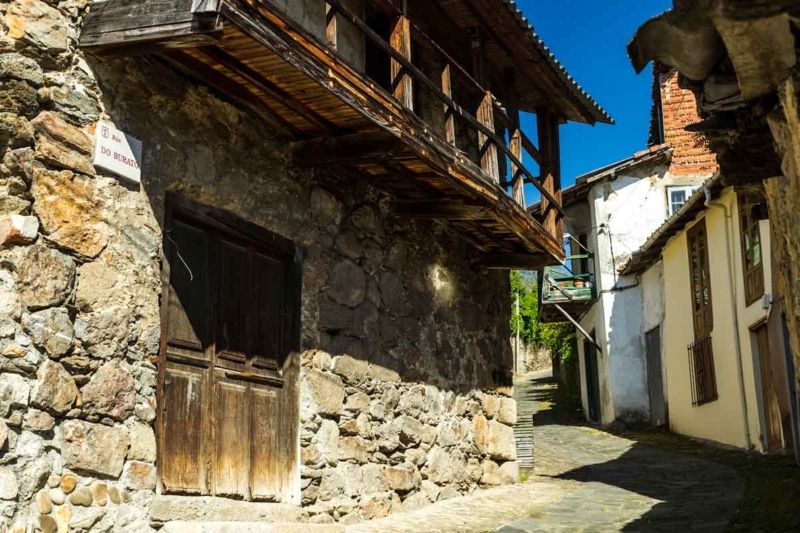At the geographic center of Ribeira Sacra (Galicia), Monforte de Lemos is both a medieval hilltown and a living archive of Sephardic heritage. The city is a proud member of the Jewish Heritage Network – Red de Juderías de España, Caminos de Sefarad, which connects destinations committed to preserving and interpreting Jewish history across Spain. Its location makes it an ideal base for combining heritage routes with wine experiences along the Mencía-lined valleys of the Cabe River.
Documentary traces of Jewish life here reach back to 915, with the mention of Ismael, a Jewish resident in the area that would become Monforte. The community grew notably after 1147, as refugees from the Almohad invasion moved north, and again after the 1391 pogroms pushed families toward safer, more tolerant enclaves.
By the 14th century, Jewish residents held trusted roles under the powerful Counts of Lemos, a relationship documented in local research and memorialized by the city’s later decision to name a central street Rúa de Raoul Wallenberg, the first in Spain, honoring solidarity and civic courage.
Monforte’s Jewish quarter was never a sealed ghetto; Jews and Christians often lived side by side, with communal life concentrated around streets such as Falagueira, Zapaterías, Pescaderías, Porta Nova and Abelardo Baanante. Local investigations and fieldwork indicate the synagogue site near Falagueira and remains of a mikveh in caves adjacent to its ruins, findings corroborated by experts. Along these lanes you can still read the city’s mercantile past in trabuleiros (stone counters built into façades), in the Gaibor family house beside the fortress gate, and in discrete symbols tied to Jewish tradition, including stars carved on the Torre del Homenaje.
 For visitors, a mapped walk from Monte de San Vicente down to the old market squares brings these clues together, and connects seamlessly to the Renaissance Colegio de Nuestra Señora de la Antigua, known as the “Galician Escorial,” where art and iconography reference biblical scenes central to Jewish-Christian history.
For visitors, a mapped walk from Monte de San Vicente down to the old market squares brings these clues together, and connects seamlessly to the Renaissance Colegio de Nuestra Señora de la Antigua, known as the “Galician Escorial,” where art and iconography reference biblical scenes central to Jewish-Christian history.
Conversos, Sayings, and a Diaspora Surname
After 1492, Monforte became known for its many converso families, with archival processes revealing sustained inquisitorial scrutiny between the 16th and 18th centuries. Oral memory fixed this identity in local sayings, still cited in regional chronicles:
“Monforte de Lemos, Monforte dos demos, quinientos veciños, douscentos xudíos,” and another variant, “Monforte de Lemos, quinientos vecinos, trescentos ladrós.”
The Gaibor lineage, initially Jewish, later converso, figures prominently in Monforte’s narrative, with documented roles in civic life and material traces still visible in the quarter. Beyond Galicia, the surname “de Lemos” appears across Europe and the Americas in Sephardic genealogies, a spread attributed to gratitude or affiliation with the Counts of Lemos and, in many cases, to family origins in the valley itself.
Memory Made Public
Monforte’s recovery of its Sephardic story is not merely academic. The city regularly participates in the European Day of Jewish Culture, organizing guided walks, talks, and activities that frame the quarter as a classroom of living memory. In 2019, a monolith and an olive tree were installed to honor Jewish and converso families, reinforcing memory as part of everyday civic space. Campaigns like “Abre la puerta de la memoria” have used public art and social media to connect residents and visitors with this heritage, keeping Monforte’s role in the Red de Juderías visible and accessible.
Tourism Signals and Professional Insight
Heritage interest is translating into measurable demand. 18,395 visitors were recorded at municipal tourism offices in 2023, up 7.47% year-over-year; peak months clustered between June and October. In 2024, the figure rose to 19,458, the highest since the post-pandemic surge of 2021, with August accounting for nearly a third of visits, evidence of a maturing offer that pairs interior cultural tourism with seasonal events.









